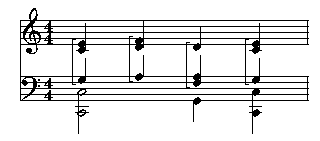In keyboard music, sometimes a bracket is drawn to indicate that
notes from two staffs are to be played
with the same hand. The bracket is really just a vertical line with short
horizontal lines at each end. But if you need to make lots of brackets,
a macro with parameters can be very helpful.
score staffs=2 staff 2 clef=bass vscheme=2f // Define a macro to draw a bracket to show that notes on two // different staffs are to be played with the same hand. // The parameters are location tags for the top and bottom notes // to be included in the bracket. define BRACK(TOP, BOT) // Draw a short horizontal line 0.5 stepsizes above the top note line (TOP.w - 2, TOP.n + 0.5) to (TOP.w - 1, TOP.n + 0.5) // Draw a vertical line from 0.5 stepsizes above the top note // to 0.5 stepsizes below the bottom note. // Do all the 'x' coordinates relative to the same note (in // this case the top), so that if the top and bottom chord happen // to be different widths, the line will still be vertical. line (TOP.w - 2, TOP.n + 0.5) to (TOP.w - 2, BOT.s - 0.5) // Draw short horizontal line just below and left of the bottom note. line (TOP.w - 2, BOT.s - 0.5) to (TOP.w - 1, BOT.s - 0.5) @ music // For each chord that is to get a bracket, add some padding to // make sure there is enough room, and set a location tag // on the top and bottom notes. 1: [pad 2] ce =a;[] df =b; [] d =c; [] ce =d; 2: [pad 2] g =e; [] a =f; [] af =g; [] g =h; 2 2: 2cc-; 4g-; cc-; // Now draw the brackets, using the tags as parameters BRACK (a, e) BRACK (b, f) BRACK (c, g) BRACK (d, h) bar
